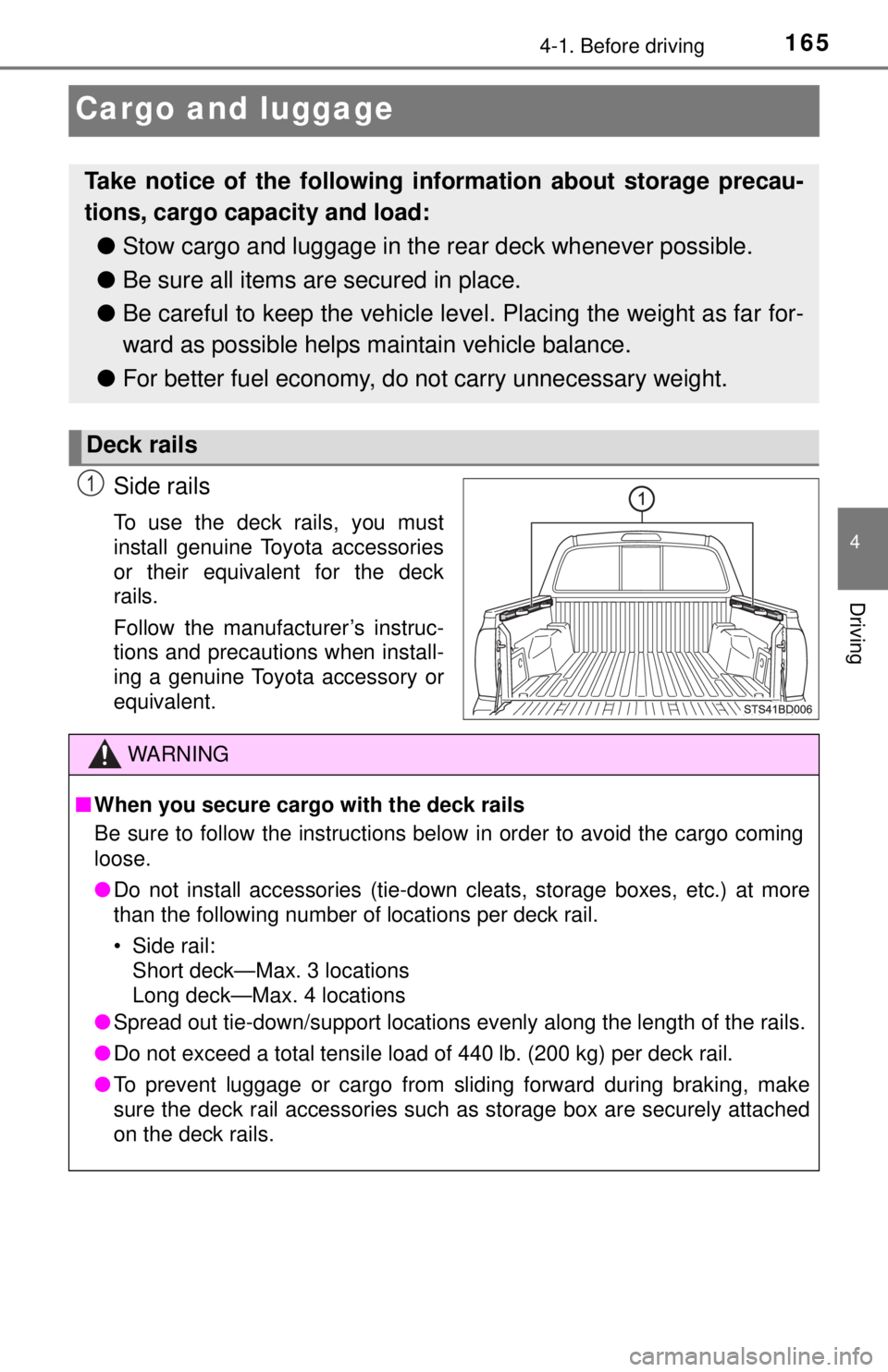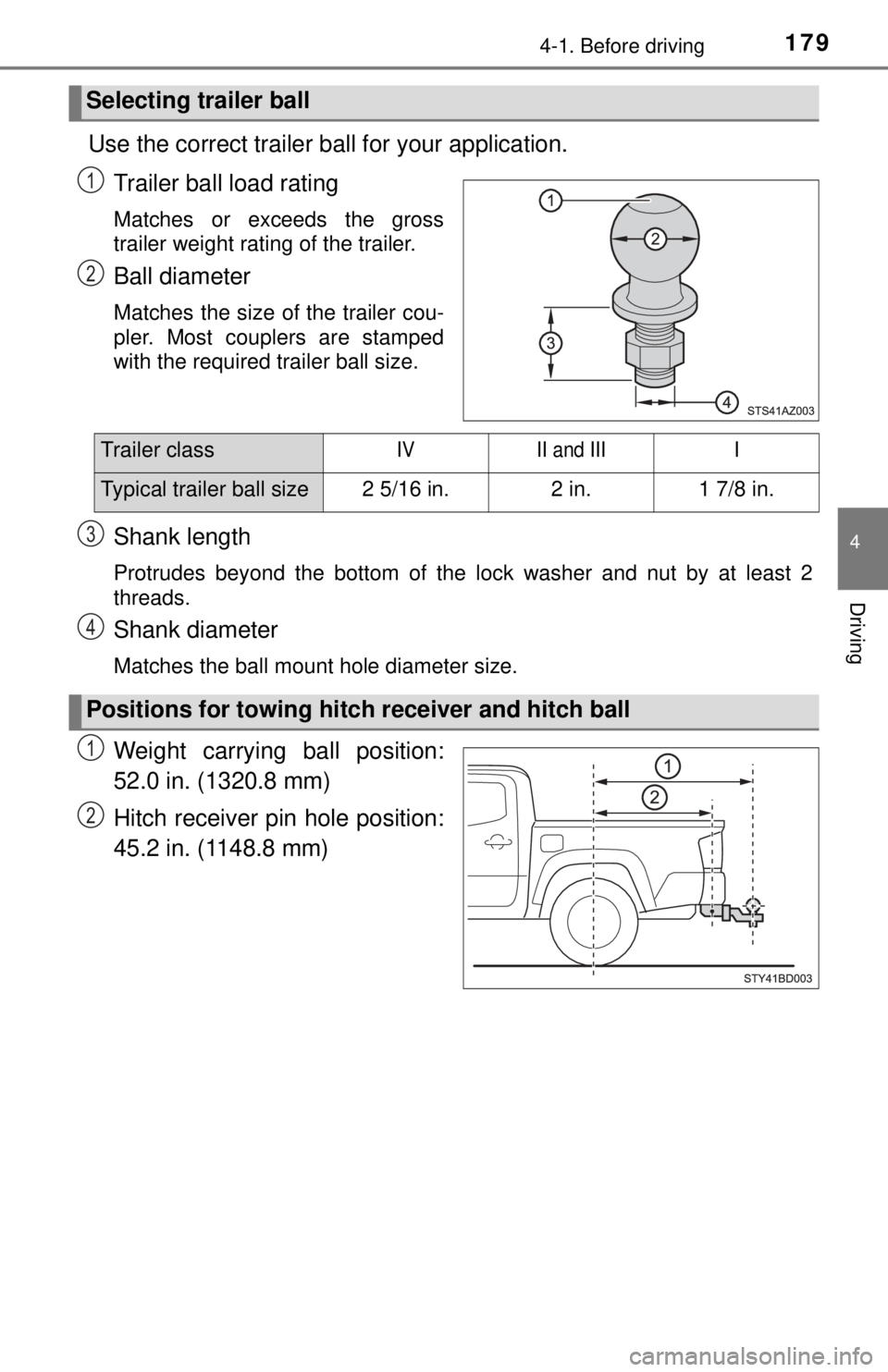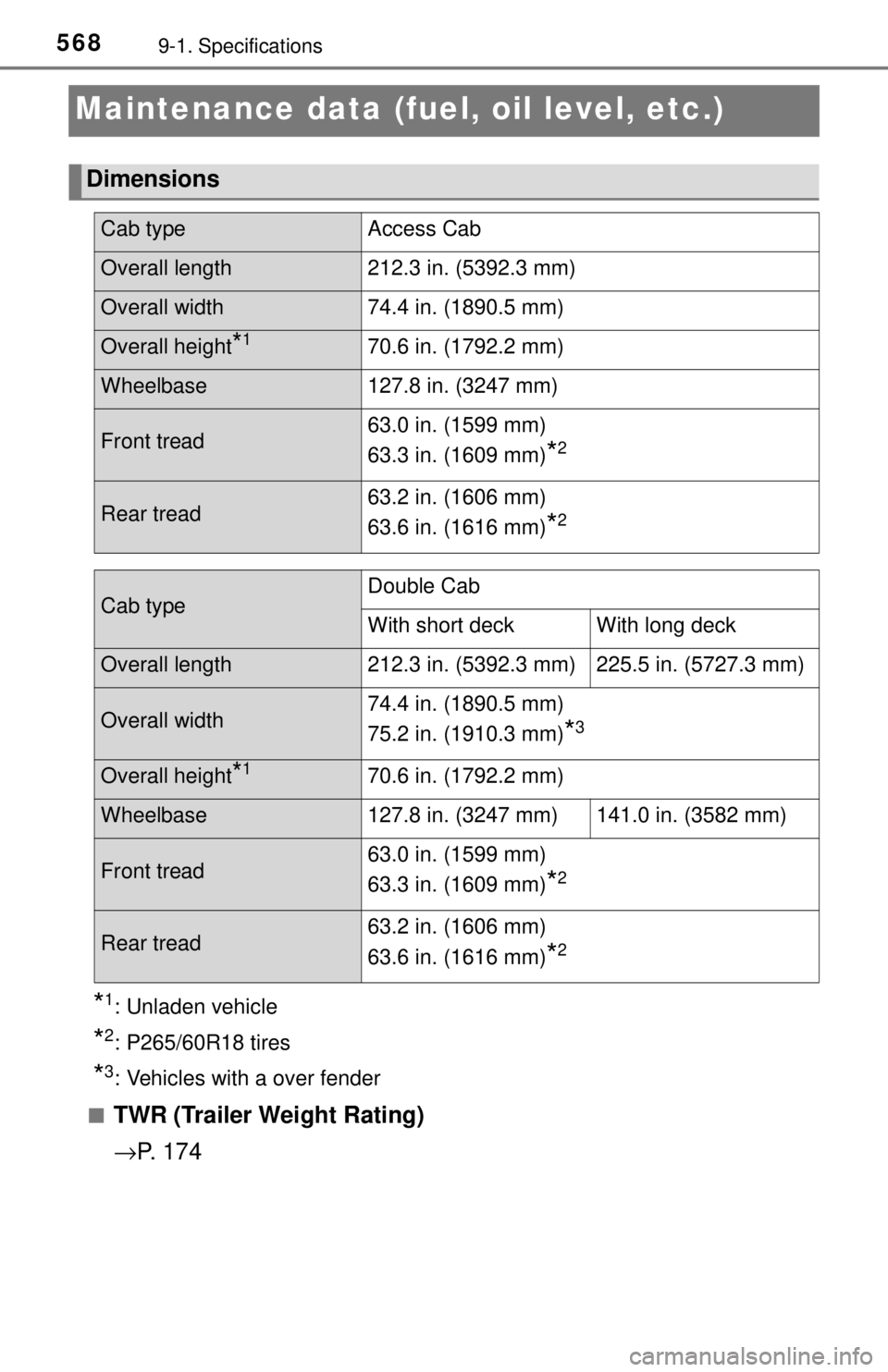2017 TOYOTA TACOMA length
[x] Cancel search: lengthPage 165 of 640

1654-1. Before driving
4
Driving
Cargo and luggage
Side rails
To use the deck rails, you must
install genuine Toyota accessories
or their equivalent for the deck
rails.
Follow the manufacturer’s instruc-
tions and precautions when install-
ing a genuine Toyota accessory or
equivalent.
Take notice of the following information about storage precau-
tions, cargo capacity and load:● Stow cargo and luggage in the rear deck whenever possible.
● Be sure all items are secured in place.
● Be careful to keep the vehicle leve l. Placing the weight as far for-
ward as possible helps maintain vehicle balance.
● For better fuel economy, do not carry unnecessary weight.
Deck rails
1
WARNING
■When you secure cargo with the deck rails
Be sure to follow the instructions below in order to avoid the cargo coming
loose.
● Do not install accessories (tie-down cleats, storage boxes, etc.) at more
than the following number of locations per deck rail.
• Side rail:
Short deck—Max. 3 locations
Long deck—Max. 4 locations
● Spread out tie-down/support locations evenly along the length of the rails.
● Do not exceed a total tensile load of 440 lb. (200 kg) per deck rail.
● To prevent luggage or cargo from sliding forward during braking, make
sure the deck rail accessories such as storage box are securely attached
on the deck rails.
Page 179 of 640

1794-1. Before driving
4
Driving
Use the correct trailer ball for your application.Trailer ball load rating
Matches or exceeds the gross
trailer weight rating of the trailer.
Ball diameter
Matches the size of the trailer cou-
pler. Most couplers are stamped
with the required trailer ball size.
Shank length
Protrudes beyond the bottom of the lock washer and nut by at least 2
threads.
Shank diameter
Matches the ball mount hole diameter size.
Weight carrying ball position:
52.0 in. (1320.8 mm)
Hitch receiver pin hole position:
45.2 in. (1148.8 mm)
Selecting trailer ball
1
2
Trailer classIVII and IIII
Typical trailer ball size2 5/16 in.2 in.1 7/8 in.
Positions for towing hitch receiver and hitch ball
3
4
1
2
Page 181 of 640

1814-1. Before driving
4
Driving
Your vehicle will handle differently when towing a trailer. To help avoid
an accident, death or serious injury, keep the following in mind when
towing:
● Speed limits for towing a trailer vary by state or province. Do not
exceed the posted to wing speed limit.
● Toyota recommends that the vehi cle-trailer speed limit is 65 mph
(104 km/h) on a flat, straight, dry road. Do not exceed this limit, the
posted towing speed limit or the spe ed limit for your trailer as set
forth in your trailer owner’s manual, whichever is lowest. Instability
of the towing vehicle-trailer combination (trailer sway) increases as
speed increases. Exceeding speed limits may cause loss of control.
● Before starting out, check the tr ailer lights, tires and the vehicle-
trailer connections. Recheck after driving a short distance.
● Practice turning, stopping and reversing with the trailer attached in
an area away from traffic until you become accustomed to the feel
of the vehicle-trailer combination.
● Reversing with a trailer attached is difficult and requires practice.
Grip the bottom of the steering wheel and move your hand to the
left to move the trailer to the left . Move your hand to the right to
move the trailer to the right. (This is generally opposite to reversing
without a trailer attached.) Avoid sharp or prolonged turning. Have
someone guide you when reversing to reduce the risk of an acci-
dent.
● As stopping distance is increased when towing a trailer, vehicle-to-
vehicle distance should be increased. For each 10 mph (16 km/h)
of speed, allow at least one vehicle and trailer length.
● Avoid sudden braking as you may skid, resulting in the trailer jack-
knifing and a loss of vehicle control. This is especially true on wet or
slippery surfaces.
● Avoid jerky starts or sudden acceleration.
● Avoid jerky steering and sharp turns, and slow down before making
a turn.
● Note that when making a turn, the trailer wheels will be closer than
the vehicle wheels to the inside of the turn. Compensate by making
a wider than normal turning radius.
Trailer towing tips
Page 182 of 640

1824-1. Before driving
●Slow down before making a turn, in crosswinds, on wet or slippery
surfaces, etc.
Increasing vehicle speed c an destabilize the trailer.
● Take care when passing other vehicles. Passing requires consider-
able distance. After passing a vehi cle, do not forget the length of
your trailer, and be sure you hav e plenty of room before changing
lanes.
● Vehicles with an automatic transm ission: To maintain engine brak-
ing efficiency and charging syst em performance when using engine
braking, do not use the transmiss ion in D. If in the S mode, the
transmission shift range position must be in 5 or lower.
● Vehicles with a manual transmission: To maintain engine braking
efficiency and charging system performance when using engine
braking, do not use t he fifth gear (5-speed manual transmission) or
the sixth gear (6-speed manual transmission).
● Instability happens more frequently when descending steep or long
downhill grades. Before descending, slow down and downshift. Do
not make sudden downshifts while descending steep or long down-
hill grades.
● Avoid holding the brake pedal down too long or applying the brakes
too frequently. This could cause the brakes to overheat and result in
reduced braking efficiency.
● Due to the added load of the trailer, your vehicle’s engine may over-
heat on hot days (at temperatures over 85°F [30°C]) when driving
up a long or steep grade. If t he engine coolant temperature gauge
indicates overheating, immediately turn off the air conditioning (if in
use), pull your vehicle off the road and stop in a safe spot.
( → P. 563)
Page 306 of 640

3065-5. Playing an audio CD and MP3/WMA/AAC discs
●WMA file compatibility
• Compatible standards
WMA Ver. 7, 8, 9 (only compatible with Windows Media Audio Standard)
• Compatible sampling frequencies 32, 44.1, 48 (kHz)
• Compatible bit rates (only compatible with 2-channel playback) Ver. 7, 8: CBR 48-192 (kbps)
Ver. 9: CBR 48-320 (kbps)
● AAC file compatibility
• Compatible standards
MPEG4/AAC-LC
• Compatible sampling frequencies
11.025/12/16/22.05/24/32/44.1/48 (kHz)
• Compatible bit rates 16-320 (kbps)
Compatible channel modes: 1ch and 2ch
● Compatible media
Media that can be used for MP3, WMA and AAC playback are CD-Rs and
CD-RWs.
Playback in some instances may not be possible if the CD-R or CD-RW is
not finalized. Playback may not be possible or the audio may jump if the
disc is scratched or marked with fingerprints.
● Compatible disc formats
The following disc formats can be used.
• Disc formats: CD-ROM Mode 1 and Mode 2
CD-ROM XA Mode 2, Form 1 and Form 2
• File formats: ISO9660 Level 1, Level 2, (Romeo, Joliet)
UDF (2.01 or lower)
MP3, WMA and AAC files written in any format other than those listed
above may not play correctly, and their file names and folder names may
not be displayed correctly.
Items related to standards and limitations are as follows.
• Maximum directory hierarchy: 8 levels (including the root)
• Maximum length of folder names/file names: 32 characters
• Maximum number of folders: 192 (including the root)
• Maximum number of files per disc: 255
● File names
The only files that can be recognized as MP3/WMA/AAC and played are
those with the extension .mp3, .wma or .m4a.
● Discs containing multi-session recordings
As the multimedia system is compatible with multi session discs, it is possi-
ble to play discs that contain MP3, WMA and AAC files. However, only the
first session can be played.
Page 568 of 640

5689-1. Specifications
Maintenance data (fuel, oil level, etc.)
*1: Unladen vehicle
*2: P265/60R18 tires
*3: Vehicles with a over fender
■
TWR (Trailer Weight Rating)
→ P. 1 7 4
Dimensions
Cab type Access Cab
Overall length212.3 in. (5392.3 mm)
Overall width 74.4 in. (1890.5 mm)
Overall height*170.6 in. (1792.2 mm)
Wheelbase127.8 in. (3247 mm)
Front tread63.0 in. (1599 mm)
63.3 in. (1609 mm)*2
Rear tread63.2 in. (1606 mm)
63.6 in. (1616 mm)*2
Cab typeDouble Cab
With short deck With long deck
Overall length
212.3 in. (5392.3 mm) 225.5 in. (5727.3 mm)
Overall width74.4 in. (1890.5 mm)
75.2 in. (1910.3 mm)*3
Overall height*170.6 in. (1792.2 mm)
Wheelbase
127.8 in. (3247 mm) 141.0 in. (3582 mm)
Front tread63.0 in. (1599 mm)
63.3 in. (1609 mm)*2
Rear tread63.2 in. (1606 mm)
63.6 in. (1616 mm)*2